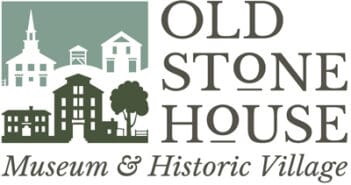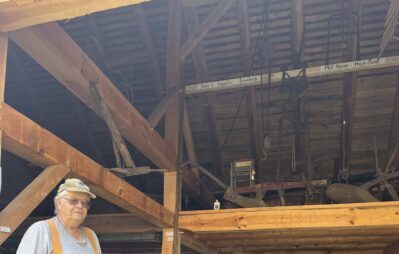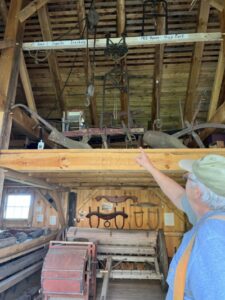
Peter pointing up at his horse hay fork, now on display in the Old Stone House Agricultural Barn
If you’ve visited the Old Stone House Museum & Historic Village you’ve likely seen Peter Martin and his impact. Peter is a long-time volunteer as well as a charismatic storyteller and educator. From his children’s program participation to his knowledge of history and farming, Peter has helped shape the Old Stone House Museum into what it is today. His generosity doesn’t just include his time and know-how, he has also donated historical items to the Museum.
The most recent addition is a beautiful 1913 horse-powered hay fork from his family’s farm, used before the invention of the hay baler.
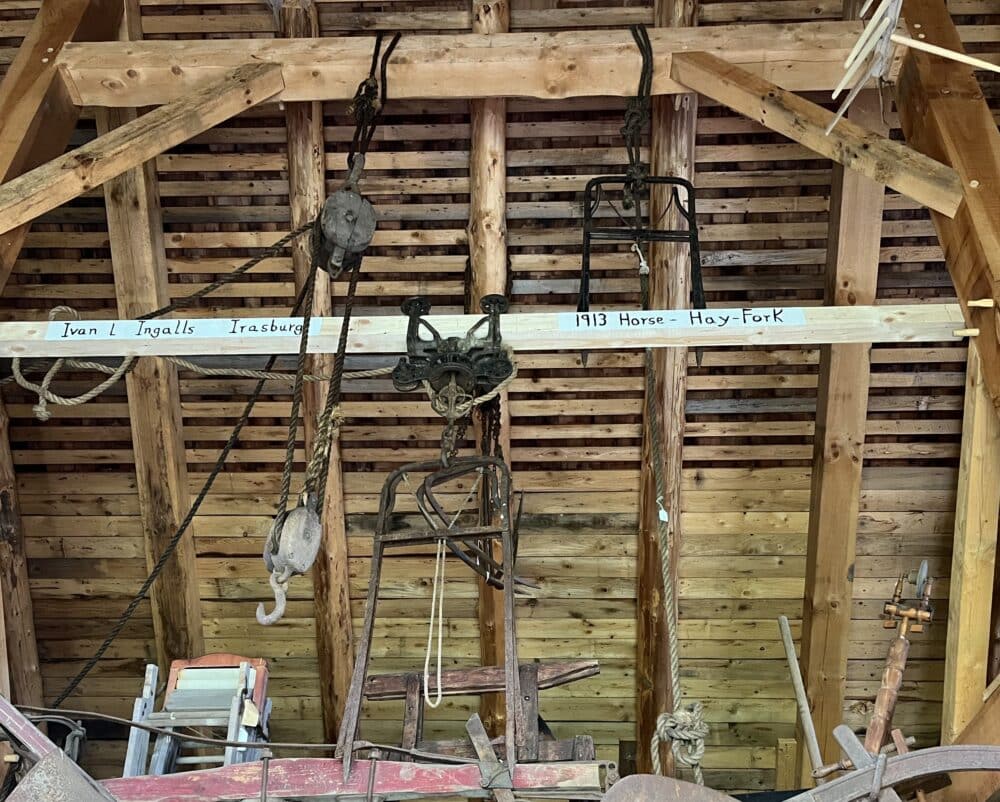
The horse hay fork, shown closer
Step into the Old Stone House Agricultural Barn, and look up; you’ll see it among the rafters with the inscription “Ivan L. Ingalls, Irasburg 1913 Horse – Hay – Fork.” The hay fork was used by Peter’s Grandfather Ivan and Uncle Roy in the early 1900s on their 183-acre farm in Irasburg.
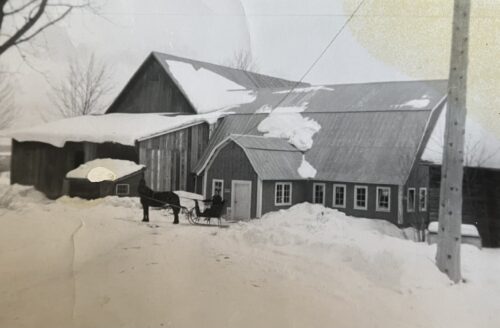
The family housekeeper, Wilma, is featured in front of the family farm barns with a Morgan horse and sleigh, photo provided by Peter Martin
This picture (right) shows the barns on his family’s farm. The newer barn built in 1960 is at the front, with the larger 1875 barn in the back. The old barn held the hay fork. The family housekeeper, Wilma, is featured with a Morgan horse and sleigh.
How did the hay fork work?
- A wagon of loose hay would be backed into the barn.
- The “double harpoon” hay fork would be lowered and forced down into the loose hay. It was then positioned to securely grab a large “chunk” of hay.
- A horse, attached to the rope and pulley system, would pull the loaded hay fork to the loft or “hay mow” of the barn.
- Someone in the hay mow would release and distribute the hay.
- This process would continue until the entire load was stored. More hay loads would be hauled to the barn floor, and the work would go on until all the hay was safely stored.
Peter’s family kept a tally of the hay loads on their milk house door. They got in about one hundred loads per season. If the hay was wet, they would cut a hole in the piles and add salt to pull moisture out and prevent spontaneous combustion. In the fall, as the hay settled in the bays, they used a hay knife to cut hay away from the cross beams; this would stop the hay from weighing down the beams. They used the horse hay fork until 1955 when they purchased their first hay baler.
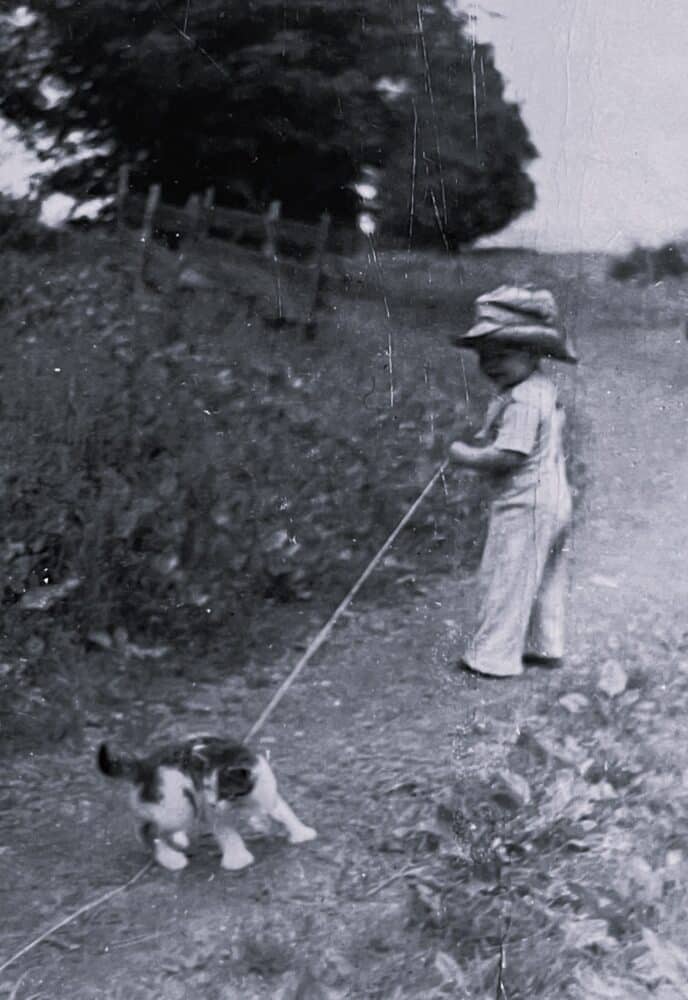
Peter as a little boy walking a cat on a leash, photo provided by Peter Martin
Peter’s life is rich with memories of the farm and stories of his adventures and family. Above is an adorable picture of him as a little boy walking a cat on a leash. He has published several fascinating stories in The Northland Journal, including one in which he recalls,
“One of my favorite memories from the early 1960s was when I spent summers on my Uncle Roy Ingalls’ farm in Irasburg…Wilma (Roy’s housekeeper) would have a pot of oatmeal cooking on the old wood stove and bran muffins cooking in a cast-iron pan in the oven.”
Peter’s father, Reuben Martin, ran a barbershop and skunk oil business in Richford:
“He [Reuben] filled baby food jars with skunk oil to be taken to the drug store to be sold for $1.25 each. When the older generation had a chest cold they’d heat this oil and put it on their chest like we do with Vicks VapoRub today.”
Peter’s Grampa Ivan was an Irasburg forest fire warden, constable, deputy sheriff and tax collector. Peter wrote in an article that Ivan was a
“…big, rugged man. Some people insisted he was the strongest man in Orleans County. Come Orleans County Fair time, which is held each year in Barton, he sometimes used his strength to make a few extra dollars.”
Peter earned an Associate of Science in Forestry at Paul Smith’s College. He then went on to get a bachelor’s and master’s from the University of Maine. He taught forestry and science for many years and even taught at the local Lake Region Union High School during the first two years of the school’s operation. Howard Frank Mosher’s wife, Phillis, taught science in the classroom next to his. Peter also went out west for a time to serve as an Extension Forester. He came back to the area in 1976, and has been retired now for fourteen years. He’s been volunteering for and contributing to the Old Stone House Museum & Historic Village since 2010.
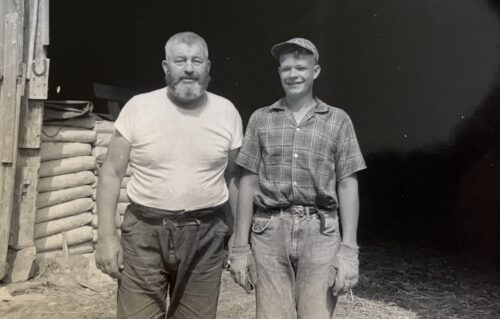
Peter, on the right, pictured with his Grampa Ivan, photo provided by Peter Martin
When his Uncle Roy passed away in 2012, Peter and his son carefully removed the hay fork from the barn to preserve it. This fall, Peter and another long-time volunteer, Jane Greenwood, installed the hay fork in the Old Stone House Barn. Peter explained he wanted the fork at the museum to preserve it and to honor his Uncle Roy and Grampa Ivan. In this photo from around 1959, Peter is pictured with Ivan.
We know his family’s hay fork will be a source of education and admiration for years to come. We are grateful for Peter and all his contributions to the Old Stone House Museum & Historic Village and all the ways he has connected with the staff and other volunteers here at the museum.
